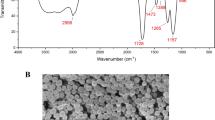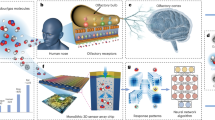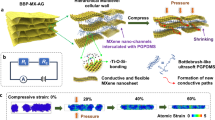Abstract
Odour perception in humans can sometimes discriminate different enantiomers of a chiral compound1,2,3, such as limonene. Chiral discrimination represents one of the greatest challenges in attempts to devise selective and sensitive gas sensors. The importance of such discrimination for pharmacology is clear, as the physiological effect of enantiomers of drugs and other biologically active molecules may differ significantly4. Here we describe two different sensor systems that are capable of recognizing different enantiomers and of qualitatively monitoring the enantiomeric composition of amino-acid derivatives and lactates in the gas phase. One sensor detects changes in mass, owing to binding of the compound being analysed (the ‘analyte’), by thickness shear-mode resonance5,6,7; the other detects changes in the thickness of a surface layer by reflectometric interference spectroscopy8,9,10. Both devices use the two enantiomers of a chiral polymeric receptor, and offer rapid on-line detection of chiral species with high selectivity.
This is a preview of subscription content, access via your institution
Access options
Subscribe to this journal
Receive 51 print issues and online access
$199.00 per year
only $3.90 per issue
Buy this article
- Purchase on Springer Link
- Instant access to full article PDF
Prices may be subject to local taxes which are calculated during checkout




Similar content being viewed by others
References
Ohloff, G. Scent and Fragrances: The Fascination of Odors and their Chemical Perspectives (Springer, New York, (1994)).
Leitereg, T. J., Guadagni, D. G., Harris, J., Mon, T. R. & Teranishi, R. Evidence for the difference between the odors of the optical isomers (+)- and (−)-carvone. Nature 230, 455–456 (1971).
Friedman, L. & Miller, J. G. Odor in congruity and chirality. Science 172, 1044–1046 (1971).
Franks, N. P. & Lieb, W. R. Stereospecific effects of inhalation general anesthetic optical isomers on nerve ion channels. Science 254, 427–430 (1991); Molecular and cellular mechanisms of general anaesthesia. Nature 367, 607–613 (1994).
Grate, J. W., Martin, S. J. & White, R. M. Acoustic wave microsensors, Part I and II. Anal. Chem. 65, 940A–948A, 987A–996A (1993).
Nieuwenhuizen, M. S. & Venema, A. Surface acoustic wave chemical sensors. Sens. Mater. 5, 261–300 (1989).
Bodenhöfer, K., Hierlemann, A., Noetzel, G., Weimar, U. & Göpel, W. Performances of mass-sensitive devices for gas sensing: thickness shear mode and surface acoustic wave transducers. Anal. Chem. 68, 2210–2218 (1996).
Gauglitz, G., Brecht, A., Kraus, G. & Nahm, W. Chemical and biochemical sensors based on interferometry at thin layers. Sens. Actuators B 11, 21–27 (1993).
Brecht, A. & Gauglitz, G. Optimised layer system for immunosensors based on the RIfS transducer. Fresenius J. Anal. Chem. 349, 360–366 (1994).
Piehler, J., Brecht, A. & Gauglitz, A. Affinity detection of low molecular weight analytes. Anal. Chem. 68, 139–143 (1996).
Anholt, R. R. H. Primary events in olfactory reception. Trends Biochem. Sci. 12, 58–62 (1987).
Rawn, J. D. Biochemistry (Patterson, Burlington, (1989)).
Frank, H., Nicholson, G. J. & Bayer, E. J. Rapid gas chromatographic separation of amino acid enantiomers with a novel chiral stationary phase. Chromatogr. Sci. 15, 174–176 (1977).
Koppenhoefer, B., Mühleck, U. & Lohmiller, K. Backbone modification of Chirasil-Val: effect of nonpolar side chains on enantiomer separation in GC. Chromatographia 40, 718–723 (1995).
Trettin, U. Wechselwirkung von Enantiomeren in unverdünnten Flüssigkeiten. Thesis, Univ. Tübingen((1993)).
Schurig, V. Enantiomer analysis by complexation GC: scope, merits, limitations. J. Chromatogr. 441, 135–153 (1988).
Meinwald, J. et al. Inhalational anesthetics stereochemistry: Optical resolution of halothane, enflurane and isoflurane. Science 251, 560–561 (1991).
Koppenhoefer, B. & Bayer, E. Chiral recognition in the resolution of enantiomers by GLC. Chromatographia 19, 123–130 (1984).
König, W. A. Separation of enantiomers by capillary GC with chiral stationary phases J. High Resolut. Chromatogr. Chromatogr. Commun. 5, 588–595 (1982).
Kubo, Y., Maeda, S., Tokita, S. & Kubo, M. Colorimetric chiral recognition by a molecular sensor. Nature 382, 522–524 (1996).
James, T. D., Sandanayake, K. R. A. S. & Shinkai, S. Chiral discrimination of monosaccharides using a fluorescent molecular sensor. Nature 374, 345–347 (1995).
Ide, J., Nakamoto, T. & Moriizumi, T. Discrimination of aromatic optical isomers using quartz resonator sensors. Sens. Actuators A 49, 73–78 (1995).
Sauerbrey, G. Verwendung von Schwingquarzen zur Wägung dünner Schichten und zur Mikrowägung. Z. Phys. 155, 206–222 (1959).
Acknowledgements
We thank H.-G. Brendle, R. Schlunk and B. Christian at the Institute of Organic Chemistry of the University of Tübingen for providing the enantioselective polymers and the chiral analyte N-TFA-Ala-OMe. This work was supported by the Deutsche Forschungsgemeinschaft.
Author information
Authors and Affiliations
Corresponding author
Rights and permissions
About this article
Cite this article
Bodenhöfer, K., Hierlemann, A., Seemann, J. et al. Chiral discrimination using piezoelectric and optical gas sensors. Nature 387, 577–580 (1997). https://doi.org/10.1038/42426
Received:
Accepted:
Issue Date:
DOI: https://doi.org/10.1038/42426
This article is cited by
-
Effective chirality discrimination via dissipation dynamics
Quantum Information Processing (2023)
-
Gas sensors based on mass-sensitive transducers. Part 2: Improving the sensors towards practical application
Analytical and Bioanalytical Chemistry (2020)
-
Selective chiral recognition of alanine enantiomers by chiral calix[4]arene coated quartz crystal microbalance sensors
Analytical and Bioanalytical Chemistry (2019)
-
Synthesis and characterization of D-/L-methionine grafted PEDOTs for selective recognition of 3,4-dihydroxyphenylalanine enantiomers
Chinese Journal of Polymer Science (2016)
-
A liquid crystalline chirality balance for vapours
Nature Communications (2014)
Comments
By submitting a comment you agree to abide by our Terms and Community Guidelines. If you find something abusive or that does not comply with our terms or guidelines please flag it as inappropriate.



